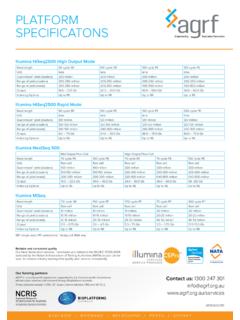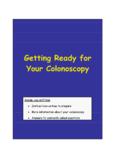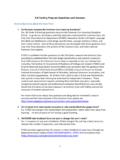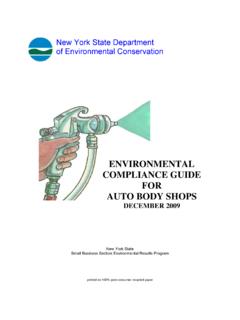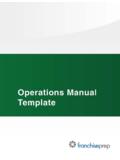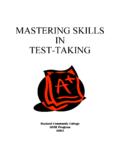Transcription of Next-Generation Sequencing: Sample Preparation Guide
1 Next-Generation sequencing : Sample Preparation Guide Use this Guide to help prepare your samples for submission to our next generation sequencing services. The outcome of your next generation sequencing project can be affected by the quality and quantity of starting nucleic acid template. Before submitting your samples please ensure that they meet the Sample submission criteria listed below. CONTENTS. 1 Sample Labelling and Packaging .. 1. 2 Amplicons .. 1. 3 Genomic 2. 4 ChIP-Seq .. 2. 5 RNA .. 3. 6 sequencing Libraries .. 3. 1 Sample Labelling and Packaging It is important that your samples are clearly labelled with permanent marker pen or adhesive labels (please ensure the labels will withstand any freezing). Sample names should be simple with up to 8 alpha-numeric characters (avoid using spaces and punctuation characters).
2 We recommend or 2 ml screw-cap DNase- and RNase-free microcentrifuge tubes Please use Parafilm to seal each tube before package. To prevent crushing during shipping, place the Sample tubes a 50 ml tube (Falcon tube) or a freezer box (with internal rack). samples can be further secured with padding such as paper towel or tissue. 2 Amplicons DNA must have an A260/280 ratio of We recommend that DNA concentration be assessed by fluorometry (Picogreen, Qubit QuantIt or similar assay). Amplicons for Nextera XT Sample prep should be >300 bp Page 1 of 3. Next-Generation sequencing Sample Preparation Guide Release Date: 15/12/14. 3 Genomic DNA. DNA must be high molecular weight (>40Kb) and free of RNA as assessed by gel electrophoresis DNA must have an A260/280 ratio of We recommend that DNA concentration be assessed by fluorometry (Picogreen, Qubit QuantIt or similar assay).
3 Gel electrophoresis results should be included when submitting Sample (s). Library Sample DNA DNA. Recommended Buffer Type Quantity Concentration Shotgun, bead gDNA 1 g 20 ng/ L Nuclease free water, TE. size selection Buffer Shotgun, Pippin Prep size gDNA 5 g 100ng/ L Nuclease free water, TE. Buffer selection Nextera gDNA 500 ng 20 ng/ L Nuclease free water pH Nextera XT gDNA 200 ng 10 ng/ L Nuclease free water pH Mate Pair gDNA > 20 g 100ng/ L Nuclease free water pH 4 ChIP-Seq 20 ng of ChIP DNA. ChIP DNA should be between 200-600 bp We recommend that DNA concentration be assessed by fluorometry (Picogreen, Qubit Quantit or similar assay). Page 2 of 3. Next-Generation sequencing Sample Preparation Guide Release Date: 15/12/14. 5 RNA. AGRF strongly advises DNase treatment (on-column).
4 Quality of total RNA should be assessed by bioanlayzer, with a RIN (RNA Integrity Number) 8. RNA should have an A260/A280 ratio of 2. We recommend that RNA concentration be assessed by fluorometry (RiboGreen). samples should be resuspended in nuclease-free water If you are submitting for Small RNA Sample Preparation , please ensure your samples have been isolated with a protocol that will retain small RNAs such as Qiagen's miRNeasy Mini Kit or Ambion's mirVana miRNA Isolation Kit. RNA Recommended Library Sample Type RNA Quantity Concentration Buffer Nuclease free Total RNA 3 g 100 ng/ L. water mRNA-seq Nuclease free Purified mRNA 200 ng 10 ng/ L. water Whole Nuclease free Total RNA 3 g 100ng/ L. Transcriptome water Nuclease free Total RNA 3 g 100ng/ L. water Small RNA. Nuclease free enriched small RNA 500 ng 20 ng/ L.
5 Water 6 sequencing Libraries AGRF will accept sequencing libraries prepared with standard Illumina protocols Details of the library Preparation protocol must be provided AGRF requests 25 l of library at a concentration of 10 nM or greater Recommend buffer for storage and dilution of libraries is 10 mM Tris-HCl pH , Tween 20. AGRF will perform a quality check of each library via automated electrophoresis (Agilent Tape Screen or Bioanalyzer) and qPCR. Custom sequencing libraries may be accepted on consultation (custom sequencing primer must be provided at 100 M). If you have any questions regarding your Sample submission please email or call us on 1300 247 301 for assistance. Page 3 of 3. Next-Generation sequencing Sample Preparation Guide Release Date: 15/12/14.

